Autopsy Meizu MX
Welcome, Habraludi! Last week, we had the opportunity to disassemble Meizu MX from one of the first versions (M030), which we immediately took advantage of. Some of the components in this version are not as new as in the current Meizu MX 2-core (M031) and 4-core, but the foundation is the same. Therefore, using the example of the first generation disassembled Meizu MX, we can see which components are used in the smartphone, how they are assembled inside the case and how the device is assembled as a whole.
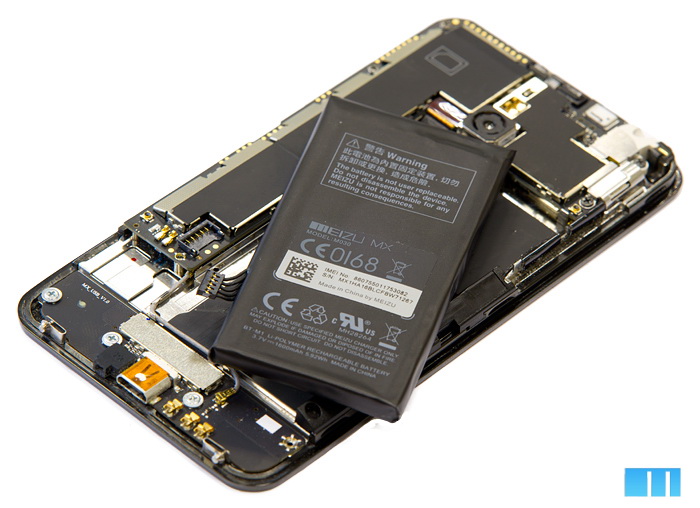
')
We apologize in advance that not all disassembly steps were illustrated, the next time (using the example of Meizu MX2), we will correct this defect. The Meizu MX case is collapsible, the lid is mounted on two brackets in the lower area of the case, as well as using plastic latches along the entire perimeter of the inner side. The fastening of the cover in Meizu MX is not the best, without a hint or instruction, not everyone will immediately figure out how it opens and in the next smartphone should be corrected. In theory, the lid is removed simply - the two brackets at the bottom are pressed through, fixed in this position, resting on the inner edge of the lid and then you just need to pull the lid towards yourself. In reality, the brackets are sometimes not fixed, and after you push them through, they get into the slots again. It is necessary to get out: to keep one bracket pressed in while you are trying to press the second one is not very convenient.
The Meizu MX cover is two-layered, the inner layer is matte white plastic with a thickness of about 0.6 mm, the outer one is transparent plastic with a thickness of approximately 0.5 mm. Due to the fact that the transparent plastic is superimposed on the matte, a feeling of "lightness" of the cover is created. All Meizu MX models are compatible with replaceable covers made using the same technology. Replaceable covers have internal plastic in one of several colors: pink, beige, lilac or green. All colors are dull.
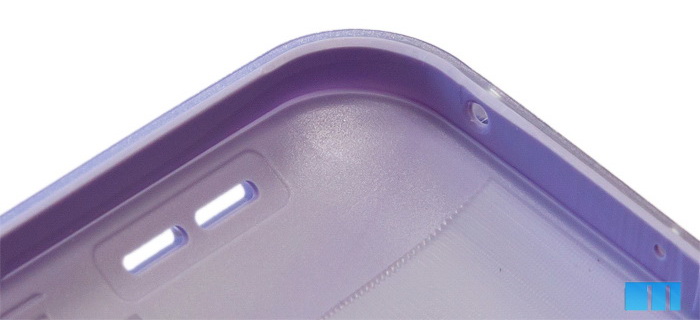
On the lid is a protective transparent plastic for the camera lens, just above the LED is located on a small PCB element with two contacts.
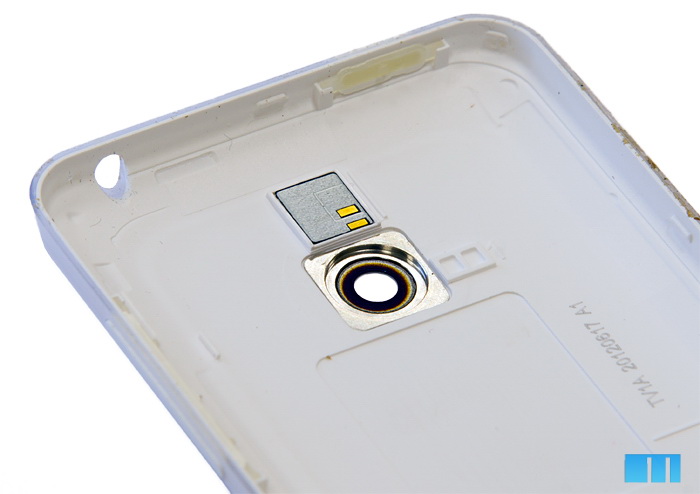
Put the cover aside and look at the inside of the case. Here we see a battery, a unit with antennas (below) and the main L-shaped board, almost all of its surface is hidden by metal screens.
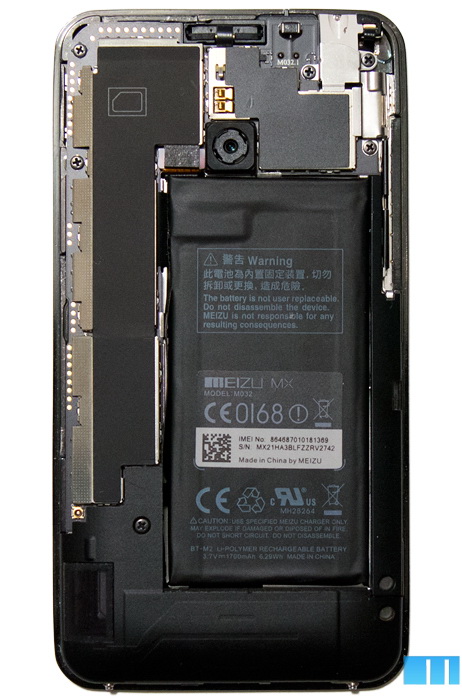
The smartphone battery can be called removable only with a reservation. Yes, you can take it off yourself, but this should be done very carefully. The battery comes into contact with the device using a small cable in the lower part of the case (in the new Meizu MX, the battery connects to the smartphone a little differently).
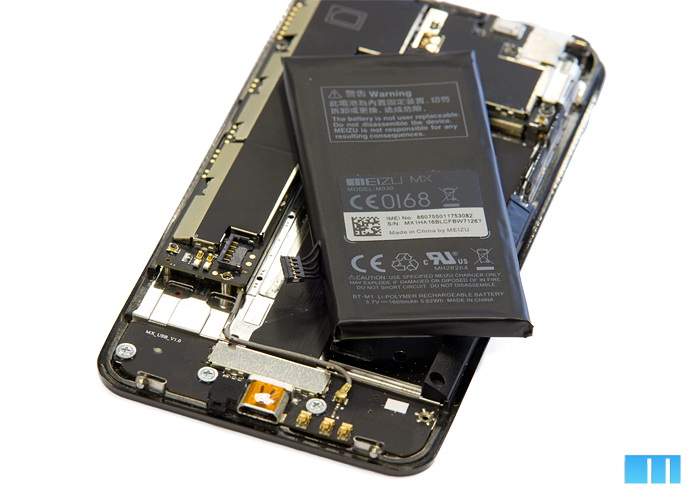
To remove the battery, you need to disconnect the cable, and then gently hook the battery around the perimeter, it is attached to the case from the inside with double-sided adhesive tape.
In order to detach the part with the antennas from the case, you need to unscrew one screw and gently pry it up; it is fastened not only with a screw, but also with plastic clips.
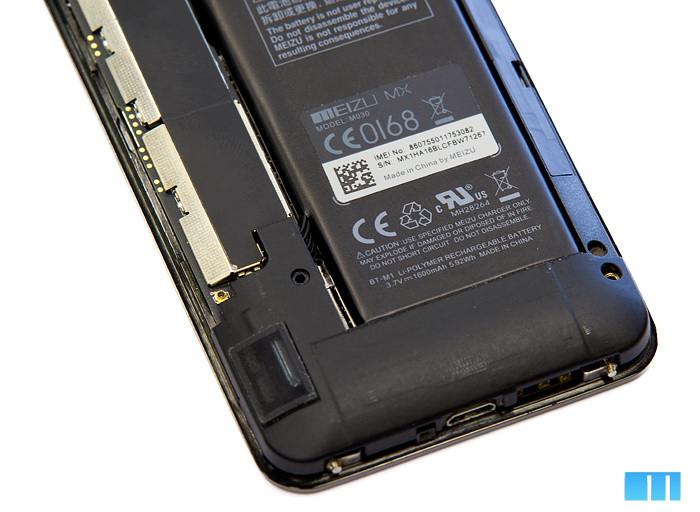
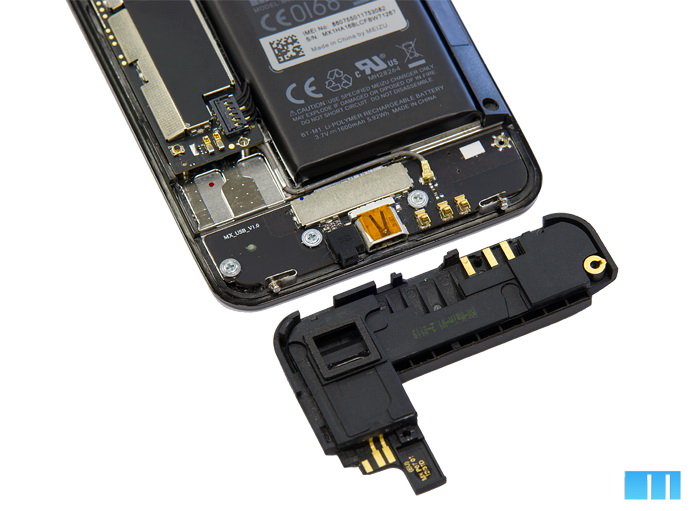
Inside this plastic L-shaped part there is a ringing speaker and antenna.
Increase the body area under this element, here is the microUSB jack, microphone (to the left of the microUSB) and contacts for installing the part with the antenna and speaker.

In the upper right part of the case, on two screws, there is a small metal screen, under which there is a headphone jack (white part) and a vibration motor (to the left).
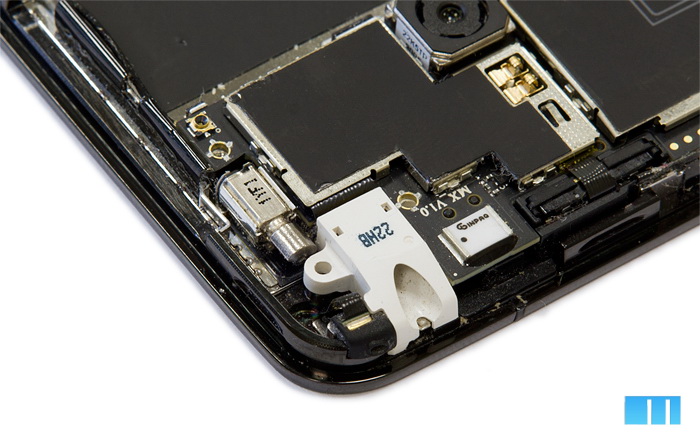
To remove the main board, you need to unscrew the six screws, disconnect the wide cable, remove the battery and remove the plastic part at the bottom (we have already done all this). The board itself is closed on both sides with screens, they are fastened with brackets, each of the screens must be carefully removed. As a result, we get the main board in this form:
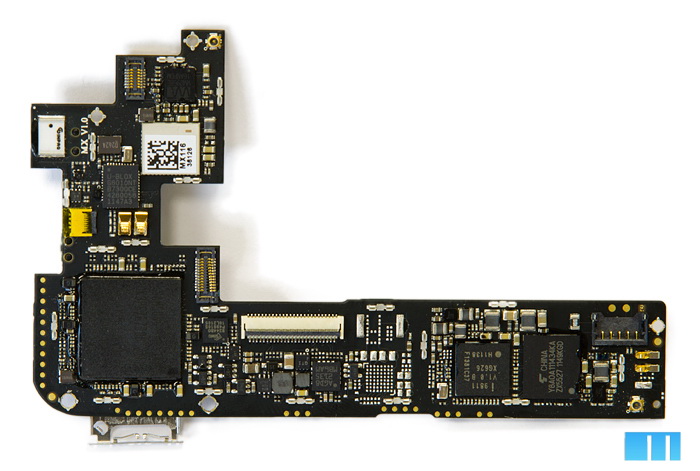

Let's see where and what elements are located here.
At one corner of the board, on one side is the “heart of the smartphone” - a CPU based on the Samsung Exynos 4210 platform. In the pictures you see the first dual-core version of the device, the new Meizu MX 2-core uses the Exynos 4212 platform.
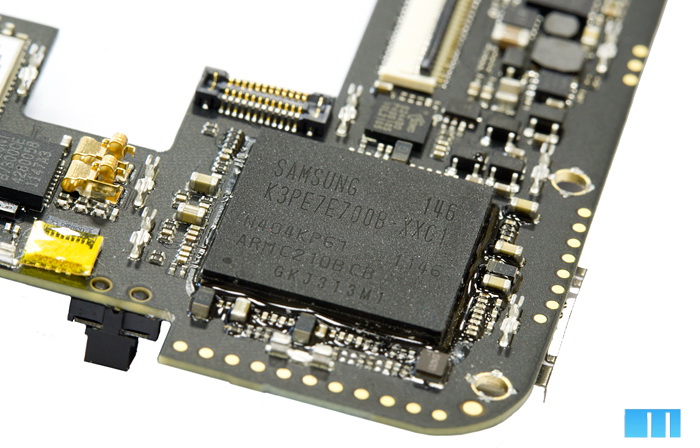
On the official Samsung website there is a page describing the general features of the platform, here it is .
 Samsung Exynos 4210 Platform Description
Samsung Exynos 4210 Platform Description
There is similar information on the Exynos 4412 platform, it is used in the Meizu MX 4-core. Here is a general information, and below pdf.
 Samsung Exynos 4412 platform description
Samsung Exynos 4412 platform description
Near this element are the GPS (U-BLOX) and Wi-Fi chips (with Data Martix).

The U-BLOX G6010NT chip is one of the most compact GPS chips of 2011, more detailed information about it can be obtained on the company's official page here or from a pdf file.
 Description of the U-BLOX G6010NT GPS Chip
Description of the U-BLOX G6010NT GPS Chip
Further away, on the same side of the board, there is a sound chip made by Wolfson Microelectronics, model WM8958E.

Wolfson is known for its portable audio chip. In particular, they are used in some tablets, for example, HP TouchPad and Lenovo ThinkPad Tablet, as well as in many top Samsung products: Samsung Galaxy S III smartphones ( proof ), Note II ( proof ) and tablets. You can read more about the WM8958E audio chip on the manufacturer’s official website here .
 Description of the Wolfson WM8958 audio chip
Description of the Wolfson WM8958 audio chip
If you look at the other side of the board from the CPU, you will see two more chips - the RAM (on the left) and the radio module. The Meizu MX 2-core uses Toshiba RAM (1 GB) and the Intel XG626 radio module, the same installed in the Samsung Galaxy Nexus. The same chip is installed in some USB-modems, for example, it is used in the Huawei E369 modem.
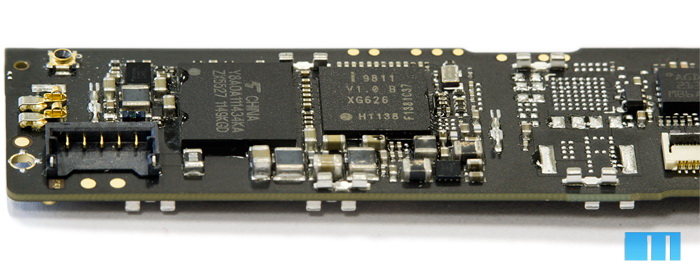
The chip was developed by Infineon before its purchase by the Intel giant and used to be called X-GOLD626, later it was named Intel / Infineon XMM6260, and now its modified version is named XMM6260. Detailed information about the chip is on the Infineion website here , as well as on the xda-developers forum, here .
 Description of the Intel XMM6260 chip
Description of the Intel XMM6260 chip
The last detail we are interested in on this side of the board is the chip responsible for the operation of the camera or the ISP chip (Image Signal Processor). Some manufacturers this year even focused on the fact that their smartphones have a hardware ISP chip. In reality, an ISP chip (integrated on a platform or separate on a motherboard) is found in almost any modern smartphone.
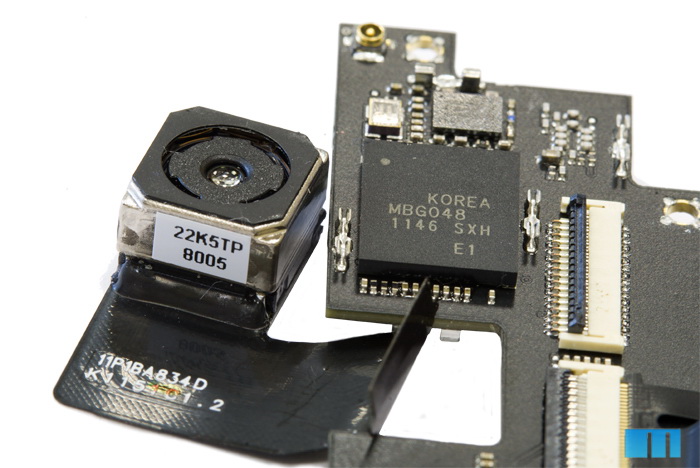
In the photo you see the Korea MBG048 ISP chip, which is responsible for processing images, as well as the main camera module. The Meizu MX has a Sony backlight module (BSI) with a resolution of 8 million pixels.
Let us turn the board over and look at the central area, here we immediately see a massive (compared to the others) chip marked with SanDisk. This is a flash-solder for data storage, the chip size in the photo is 16 GB, for the quad-core version of Meizu MX there are, respectively, 32 and 64 GB modules.
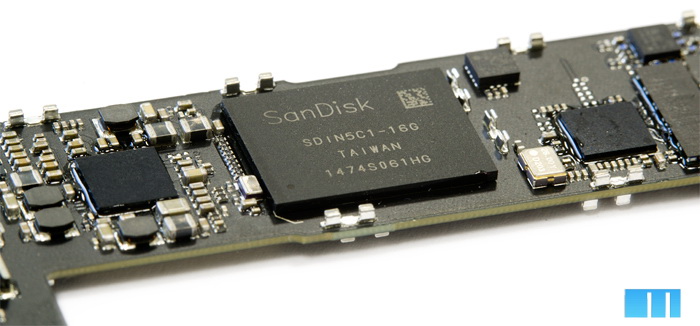
In the upper area of the board are the front camera, light sensor and proximity sensor, and to the right of these elements is the microSIM installation compartment. The SIM card is installed in a special removable compartment, which is inserted into the slot and fixed.
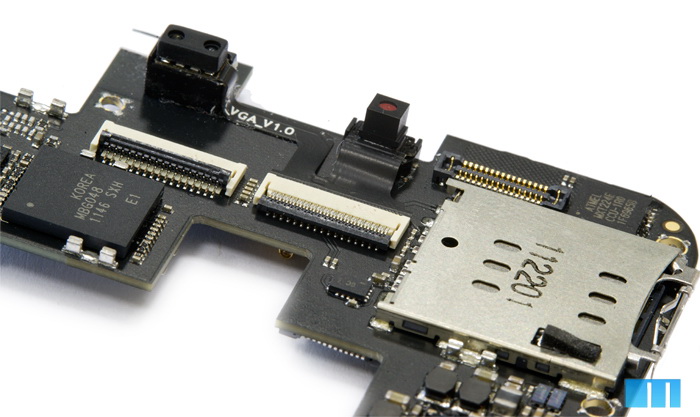
The light sensor and the proximity sensor are located on one block, the front camera is on the other, communication with the rest of the components for these three elements is provided by a common loop.

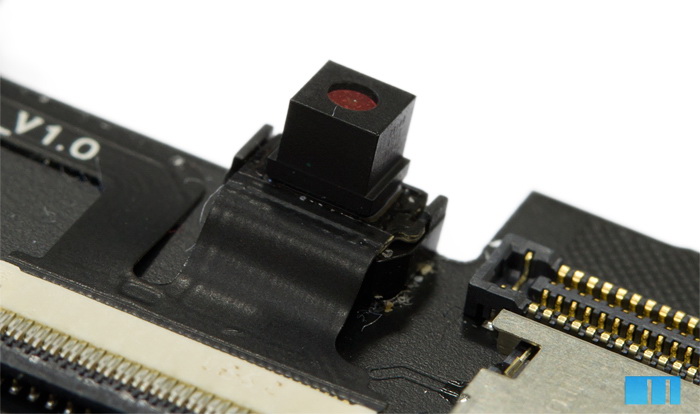
And one more important detail. Many reviews write that the Meizu MX is made entirely of plastic, it is not. In a smartphone, a metal frame cut from a single piece of aluminum (seamless and without soldering) is not difficult to notice - the thin part of this frame is also the frame of the smartphone from the front side, and the main components of the smartphone are mounted on the invisible part.
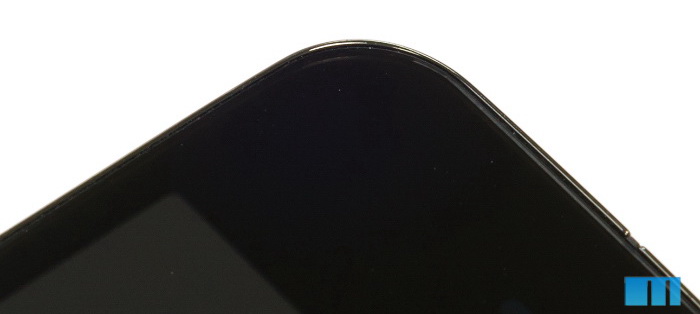
When disassembled, this element is easily determined - the entire area along the perimeter is closer to the half of the case with the screen - this frame, due to it, the necessary rigidity of the structure and reliable fastening of the elements inside the case, including the main board, are ensured.
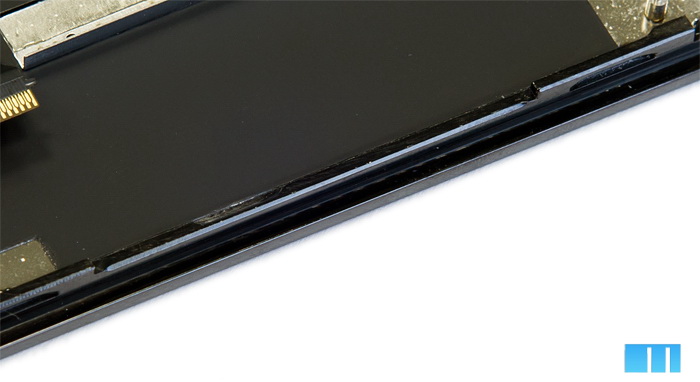
With this little material we wanted not so much to tell about the “insides” of Meizu smartphones in detail, any specialist will do it better than us and, perhaps, we will give someone to the “habr” a new smartphone to be torn apart. The task was different - to at least slightly dispel the myth that Chinese smartphones are very often made from second-class components on the knee. You yourself could be convinced that Meizu smartphones have a high build quality, a well thought-out layout of parts, we use the same components in our smartphones as the major manufacturers, such as Samsung. We are often asked why Meizu is so expensive against the background of "classmates for $ 200," because this is a "Chinese smartphone"? Few people believe in the words about the quality of the assembly and high-quality components: the processor, memory, radio module, although this is true. Our task is to produce high-quality smartphones.
Also, all information on current Meizu smartphones and news are published on our official website mymeizu.ru , and on the forum you can ask questions on these smartphones and get hints from device owners.

')
We apologize in advance that not all disassembly steps were illustrated, the next time (using the example of Meizu MX2), we will correct this defect. The Meizu MX case is collapsible, the lid is mounted on two brackets in the lower area of the case, as well as using plastic latches along the entire perimeter of the inner side. The fastening of the cover in Meizu MX is not the best, without a hint or instruction, not everyone will immediately figure out how it opens and in the next smartphone should be corrected. In theory, the lid is removed simply - the two brackets at the bottom are pressed through, fixed in this position, resting on the inner edge of the lid and then you just need to pull the lid towards yourself. In reality, the brackets are sometimes not fixed, and after you push them through, they get into the slots again. It is necessary to get out: to keep one bracket pressed in while you are trying to press the second one is not very convenient.
The Meizu MX cover is two-layered, the inner layer is matte white plastic with a thickness of about 0.6 mm, the outer one is transparent plastic with a thickness of approximately 0.5 mm. Due to the fact that the transparent plastic is superimposed on the matte, a feeling of "lightness" of the cover is created. All Meizu MX models are compatible with replaceable covers made using the same technology. Replaceable covers have internal plastic in one of several colors: pink, beige, lilac or green. All colors are dull.

On the lid is a protective transparent plastic for the camera lens, just above the LED is located on a small PCB element with two contacts.

Put the cover aside and look at the inside of the case. Here we see a battery, a unit with antennas (below) and the main L-shaped board, almost all of its surface is hidden by metal screens.

The smartphone battery can be called removable only with a reservation. Yes, you can take it off yourself, but this should be done very carefully. The battery comes into contact with the device using a small cable in the lower part of the case (in the new Meizu MX, the battery connects to the smartphone a little differently).

To remove the battery, you need to disconnect the cable, and then gently hook the battery around the perimeter, it is attached to the case from the inside with double-sided adhesive tape.
In order to detach the part with the antennas from the case, you need to unscrew one screw and gently pry it up; it is fastened not only with a screw, but also with plastic clips.


Inside this plastic L-shaped part there is a ringing speaker and antenna.
Increase the body area under this element, here is the microUSB jack, microphone (to the left of the microUSB) and contacts for installing the part with the antenna and speaker.

In the upper right part of the case, on two screws, there is a small metal screen, under which there is a headphone jack (white part) and a vibration motor (to the left).

To remove the main board, you need to unscrew the six screws, disconnect the wide cable, remove the battery and remove the plastic part at the bottom (we have already done all this). The board itself is closed on both sides with screens, they are fastened with brackets, each of the screens must be carefully removed. As a result, we get the main board in this form:


Let's see where and what elements are located here.
At one corner of the board, on one side is the “heart of the smartphone” - a CPU based on the Samsung Exynos 4210 platform. In the pictures you see the first dual-core version of the device, the new Meizu MX 2-core uses the Exynos 4212 platform.

On the official Samsung website there is a page describing the general features of the platform, here it is .
There is similar information on the Exynos 4412 platform, it is used in the Meizu MX 4-core. Here is a general information, and below pdf.
Near this element are the GPS (U-BLOX) and Wi-Fi chips (with Data Martix).

The U-BLOX G6010NT chip is one of the most compact GPS chips of 2011, more detailed information about it can be obtained on the company's official page here or from a pdf file.
Further away, on the same side of the board, there is a sound chip made by Wolfson Microelectronics, model WM8958E.

Wolfson is known for its portable audio chip. In particular, they are used in some tablets, for example, HP TouchPad and Lenovo ThinkPad Tablet, as well as in many top Samsung products: Samsung Galaxy S III smartphones ( proof ), Note II ( proof ) and tablets. You can read more about the WM8958E audio chip on the manufacturer’s official website here .
If you look at the other side of the board from the CPU, you will see two more chips - the RAM (on the left) and the radio module. The Meizu MX 2-core uses Toshiba RAM (1 GB) and the Intel XG626 radio module, the same installed in the Samsung Galaxy Nexus. The same chip is installed in some USB-modems, for example, it is used in the Huawei E369 modem.

The chip was developed by Infineon before its purchase by the Intel giant and used to be called X-GOLD626, later it was named Intel / Infineon XMM6260, and now its modified version is named XMM6260. Detailed information about the chip is on the Infineion website here , as well as on the xda-developers forum, here .
The last detail we are interested in on this side of the board is the chip responsible for the operation of the camera or the ISP chip (Image Signal Processor). Some manufacturers this year even focused on the fact that their smartphones have a hardware ISP chip. In reality, an ISP chip (integrated on a platform or separate on a motherboard) is found in almost any modern smartphone.

In the photo you see the Korea MBG048 ISP chip, which is responsible for processing images, as well as the main camera module. The Meizu MX has a Sony backlight module (BSI) with a resolution of 8 million pixels.
Let us turn the board over and look at the central area, here we immediately see a massive (compared to the others) chip marked with SanDisk. This is a flash-solder for data storage, the chip size in the photo is 16 GB, for the quad-core version of Meizu MX there are, respectively, 32 and 64 GB modules.

In the upper area of the board are the front camera, light sensor and proximity sensor, and to the right of these elements is the microSIM installation compartment. The SIM card is installed in a special removable compartment, which is inserted into the slot and fixed.

The light sensor and the proximity sensor are located on one block, the front camera is on the other, communication with the rest of the components for these three elements is provided by a common loop.


And one more important detail. Many reviews write that the Meizu MX is made entirely of plastic, it is not. In a smartphone, a metal frame cut from a single piece of aluminum (seamless and without soldering) is not difficult to notice - the thin part of this frame is also the frame of the smartphone from the front side, and the main components of the smartphone are mounted on the invisible part.

When disassembled, this element is easily determined - the entire area along the perimeter is closer to the half of the case with the screen - this frame, due to it, the necessary rigidity of the structure and reliable fastening of the elements inside the case, including the main board, are ensured.

With this little material we wanted not so much to tell about the “insides” of Meizu smartphones in detail, any specialist will do it better than us and, perhaps, we will give someone to the “habr” a new smartphone to be torn apart. The task was different - to at least slightly dispel the myth that Chinese smartphones are very often made from second-class components on the knee. You yourself could be convinced that Meizu smartphones have a high build quality, a well thought-out layout of parts, we use the same components in our smartphones as the major manufacturers, such as Samsung. We are often asked why Meizu is so expensive against the background of "classmates for $ 200," because this is a "Chinese smartphone"? Few people believe in the words about the quality of the assembly and high-quality components: the processor, memory, radio module, although this is true. Our task is to produce high-quality smartphones.
Also, all information on current Meizu smartphones and news are published on our official website mymeizu.ru , and on the forum you can ask questions on these smartphones and get hints from device owners.
Source: https://habr.com/ru/post/159171/
All Articles